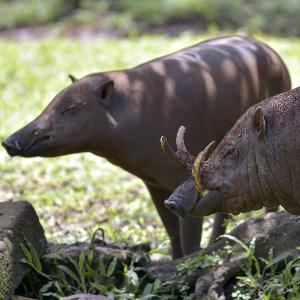Endangered mammals: populations on small islands are genetically healthier
25 Jun 2025
Researchers from Munich and London reveal that smaller islands could be key to the long-term survival of rare mammals in Indonesia.
25 Jun 2025
Researchers from Munich and London reveal that smaller islands could be key to the long-term survival of rare mammals in Indonesia.

The critically endangered babirusas belong to the pig family. | © IMAGO / Cavan Images
One of the Earth’s biodiversity hotspots is located in Southeast Asia. The region known as Wallacea encompasses a group of mainly Indonesian islands, which are famous for their exceptional species diversity and high degree of endemism. An international team led by scientists from LMU Munich and Queen Mary University of London have now demonstrated that smaller islands within the Wallacea biodiversity hotspot are important havens for endangered vertebrates, as they offer higher quality habitats than larger islands.
The researchers investigated the genetic health of babirusas (also called deer-pigs), which belong to the swine family, and of anoa, a species of wild cattle. Babirusas and anoa are both highly endangered and live only on the larger island Sulawesi and small neighboring islands. For a long time, small island populations were considered particularly at risk of extinction. But Wallacea is currently experiencing rapid land use changes, which are strongly impacting habitats on larger islands like Sulawesi in particular.
As a result, the populations of the small islands have a surprising advantage, as genetic analyses of 113 individuals of both species from different islands revealed. Although animals on smaller, less disrupted islands exhibited less genetic diversity, they also had much fewer harmful mutations. By contrast, populations on Sulawesi exhibited higher levels of inbreeding and harmful genetic variations – caused by more intensive habitat loss and human influences. “The habitat quality on the smaller islands was higher than on Sulawesi, and these areas were well protected in general. On the Togian Islands, for example, most of the land is situated within a large national park,” explains Rosie Drinkwater (LMU and Queen Mary), lead author of the study together with Dr. Sabhrina Gita Aninta (Queen Mary).
“Large populations of vertebrates on small islands are frequently viewed as endangered,” says paleogeneticist Laurent Frantz, Professor at LMU and Queen Mary and co-leader of the study. “But protecting small islands is often easier – our study shows they have huge potential to serve as safe havens for endangered species.”
“Provided of course their habitat remains intact,” adds Aninta. They remain endangered nonetheless, as they do not have many mating opportunities, or indeed much habitat. “Therefore, small islands should not be neglected in national development programs. Monitoring their current and future genetic diversity is vital in order to ensure its long-term preservation.”
Overall, conclude the researchers, these results call into question conventional conservation approaches and highlight the importance of also protecting the high-quality habitats of small islands.
S.G. Aninta, R.Drinkwater et al.: The importance of small island populations for the long-term 4 survival of endangered large-bodied insular mammals. PNAS 2025